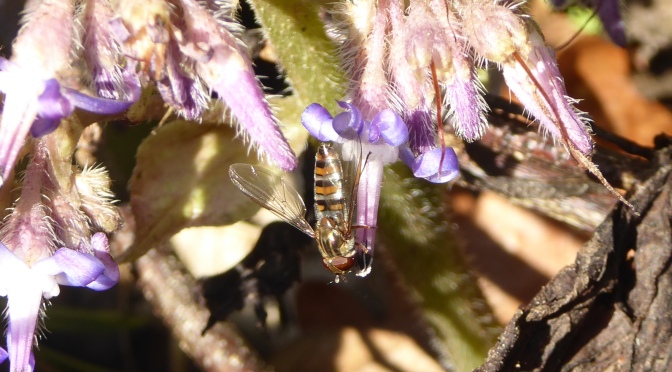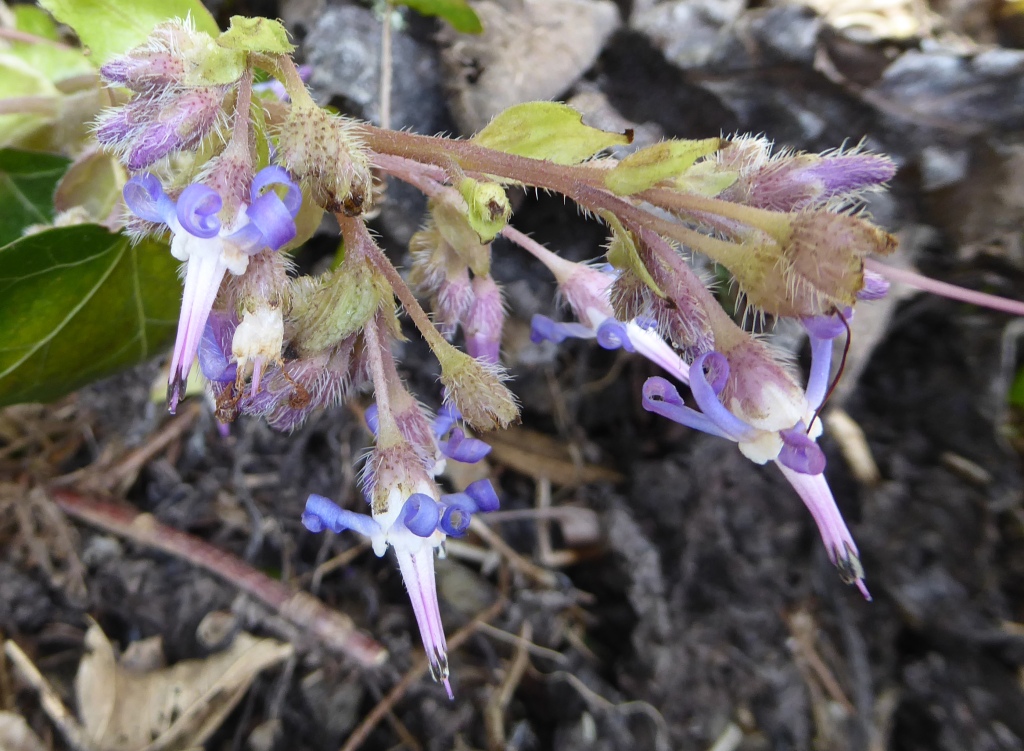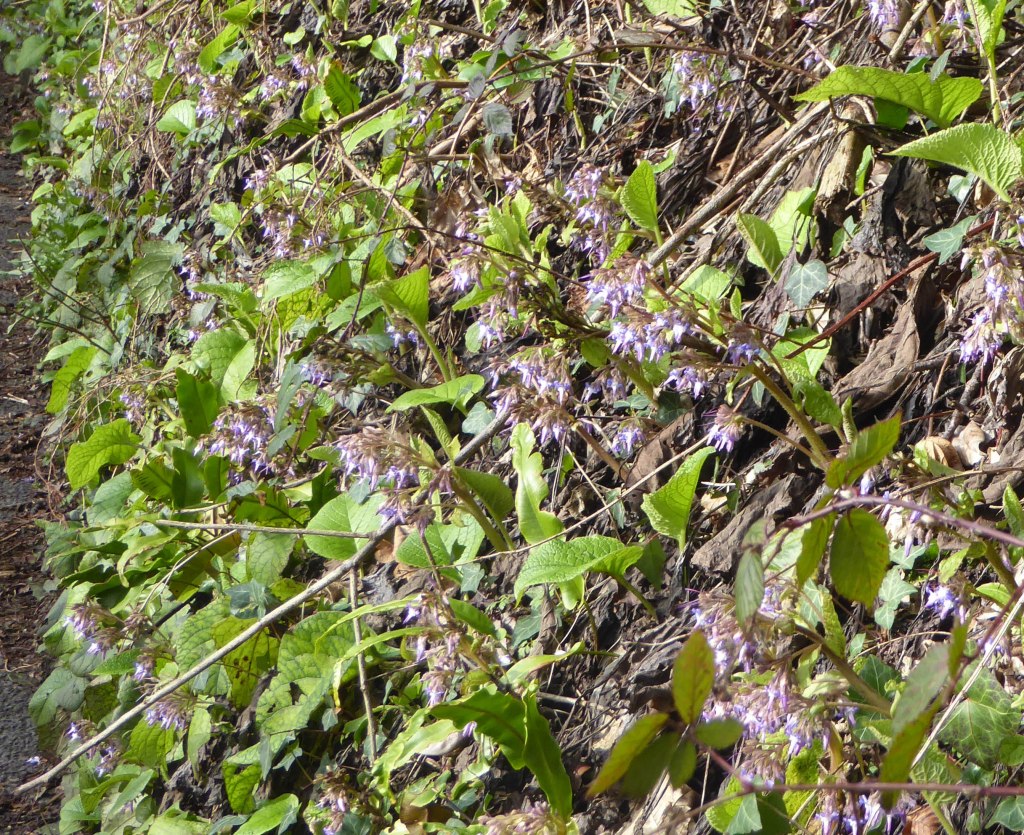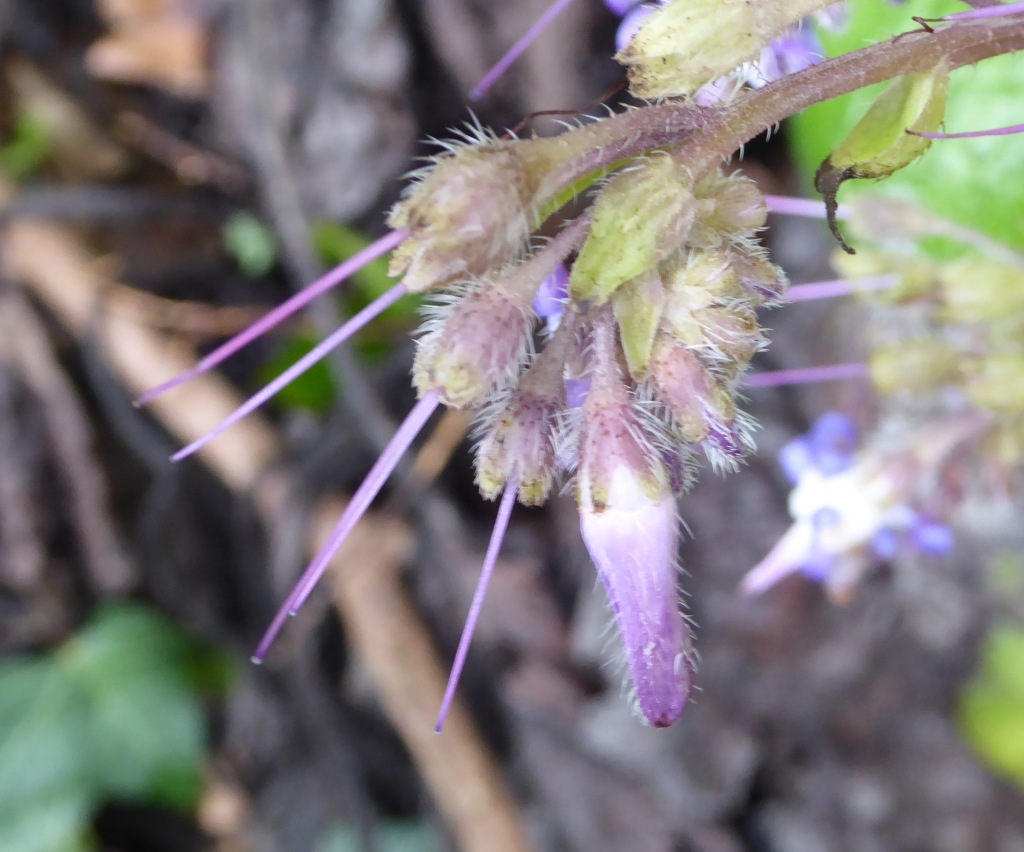For my next Lockdown Nature Walk I took advantage of a rain-free day to cross Totnes to look at some unusual flowers growing on the northern edge of the town. Here is my account of the walk (taken on January 25th 2021) together with a poem by the American poet Ruby Archer entitled Fire in the Sky. For my previous Lockdown Nature Walks, please click here.
The day dawned to a washed out, almost translucent, pale blue sky. To the east, though, there was a hint of what was to come as an apricot halo crept above the low hills as if a fire were burning behind them. Then, as the sun rose, a raft of thin cloud towards the south east caught its light, first a rose-pink, then orange before relaxing to cream. It was a good way to start the day.
No rain was forecast so I decided to walk across the town, past the castle to the northern edge, where semi-urban and residential gradually give way to rural. It was a day of light and dark, a day of bright sunshine and long shadows, and a cold day where frost lingered in areas inaccessible to the sun.
A minor road, Barracks Hill lies in this transitional zone, striking north away from the bypass past a modern housing development. The road rises gradually between rough grassy banks and then more steeply to cross a low ridge. This section of the road is enclosed and dark. It rises, like a sunken green lane, between steep sides, some rocky, some covered in rough vegetation, emerging eventually into sunshine and open countryside with farmland and trees. There was once a Barracks along this lane, built in the late 18th century. Some of the buildings remain but most were demolished when a fine Georgian house was built in the 1820s.
But I want to go back down the hill to the lower part of the lane to look at the scruffy areas of vegetation that line the road. Where it can, the sun casts pools of brightness on to these roadside banks, its spotlight picking out pennywort, hart’s tongue fern, brambles and what looks suspiciously like garden rubbish. Whatever can get a foothold here seems to flourish and there is a long section of the bank where lime green, heart-shaped leaves push through a mass of dark brown, dry, decaying vegetation. Unusually for the time of year, many sturdy flower spikes also rise above the leaves, some sporting striking blue flowers that sparkle in the sunshine like sapphire jewels. This is oriental borage (Trachystemon orientalis) commonly known as Abraham-Isaac-Jacob. A relative of wild borage (Borago officinalis), this plant was introduced into gardens in the UK in 1868 from its native Bulgaria, Georgia and Turkey where all parts of the plant are consumed as a popular spring vegetable.
This patch of the plant is probably a garden throw-out and it seems very happy here, covered in flowers and having elbowed out all the competition. At a first glance, the flowers look rather chaotic but this is because several different forms and colours exist together at the same time.
First there are the pink tapering flower buds about 1cm long, decorated with a fuzz of white hairs resembling the stubble on an old man’s chin. The buds open to reveal the strikingly beautiful complex flowers. Each has five petals that curl and twist backwards creating an intensely blue frilly decoration around a crimped white collar reminiscent of a sapphire-coloured ruff around the neck of an Elizabethan lady. Adding to the complexity, five stamens, each about 1 cm long, and a single slightly longer style protrude proudly from the collar as a tight cluster. The stamens themselves are multicoloured starting white at the top, then pinkish-lilac, terminating as indigo anthers clasping lumps of pollen.
As the flowers mature, they discard the petals and stamens leaving an odd-looking remnant where a spiky pinkish-lilac style emerges from hairy sepal cup. This form in particular contributes to the overall messy look of the plant. Unusually, all three flower forms, representing different stages of maturation, are present at the same time. This may be the inspiration for the common name of the plant, Abraham-Isaac-Jacob, itself a reference to three generations of a biblical family. [Photographs at the end of this post illustrate the three different flower forms.]
A plant that produces flowers at this low time of year is a rare discovery and these out of season sources of pollen and nectar often attract winter-active insects. Nothing was about when I looked, though, and the day was probably too cold. I came back a few days later on a warmer afternoon and was pleased to find a fine hoverfly on the flowers (see picture at the top of this post). With its bulging brown eyes and distinctive barcoded abdominal pattern of yellow, silver and black bands this was a marmalade hoverfly (Episyrphus balteatus) a species that overwinters as an adult and emerges on mild winter days. It was collecting pollen from the indigo-coloured anthers and nectar from the nectaries in the white collar.
…………………………………….
Fire in the Sky by Ruby Archer
I thought the darkness would not yield,
Glooming the sun-forgotten sky,
‘Till pulsing, surging glows revealed
A far-off burning,—home or field,
Up flung the light. Oh whence? O why?
I thought forgetfulness had spread
A Lethean gloom athwart one sky,
‘Till memory’s light crept warmly red
From flame I deemed in ashes dead.
Up leapt the light. Oh whence? Oh why?
…………………………………………………..







I’ve never heard of the Oriental Borage. It looks very pretty. I admire tough plants and it certainly seems tenacious. Beautiful picture of the hoverfly feeding on one of its flowers. Feeding doesn’t seem quite correct to me. Feeding to me implies opening your mouth and chewing and swallowing things. In France there is a verb “butiner” which you can use to describe insects taking nectar from flowers. You might say “nectaring” in English but that does not seem quite right either. Am I havering? Amelia
LikeLike
Thanks Amelia, it is quite an unusual plant. Glad you liked the picture. Perhaps “foraging” is the better term?
LikeLiked by 1 person
I think you have got it there, its more descriptive of what they are doing.
LikeLike
I contacted Prof Jeff Ollerton who has recently written a book on Pollinators and Pollination asking him about the use of feeding versus foraging. He replied on Twitter “I don’t think that it matters though I suppose the grammatical logic is that hoverflies feed as they forage”. He also commented below.
LikeLiked by 1 person
Thank you for the lovely descriptions, Philip. I have never seen oriental borage either and is amazing to see a hover fly feeding at this time of year. I use the “feeding” word with ease because, to me, I think of nutrition, and how one obtains it. I guess that must come from my neonatal nursing background with naso-gastric/IV tube feeding being common ways of getting nutrition without chewing and swallowing.
LikeLike
Thanks Ann, glad you liked the descriptions etc. Thanks also for your thoughts about “feeding”, I shall have a look at the entomological literature to see what is the best term!
LikeLike
We talk about feeding in beekeeping but it will be interesting to know what you find.
LikeLike
I contacted Prof Jeff Ollerton who has recently written a book on Pollinators and Pollination asking him about the use of feeding versus foraging. He replied on Twitter “I don’t think that it matters though I suppose the grammatical logic is that hoverflies feed as they forage”. He also commented below.
LikeLike
Wonderful detailed walk,it felt as if we were walking alongside you! I have never come across this lovely plant either. Sarah
LikeLike
Thanks Sarah for your kind words.
LikeLike
Detailed observation and vividly described
LikeLike
Thanks Jennifer.
LikeLike
“Feeding” means to “take food” or to “eat”, it implies nothing about how that food is obtained. So feeding is entirely appropriate in this context.
LikeLiked by 1 person
Thanks Jeff.
LikeLiked by 2 people